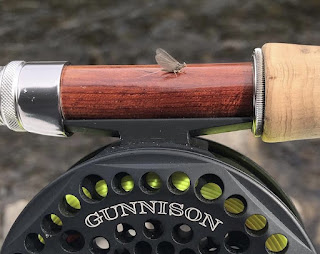Spring Dry Fly Fishing (Blue Winged Olives)
"THE OLIVES ARE COMING!"
Thankfully, that's a good thing so unlike Paul Revere, I'm a happy camper because...they are here. If you're not sure what I'm talking about, then look up Blue Winged Olives on the Google machine.
The anticipation of Spring also brings the anticipation of the first mayflies of the year, which on many rivers, are BWO's. It's interesting that because of the weather, some parts of the country have had olives for multiple weeks and other parts still have not seen them, at least not yet.
Some advice from an insightful blog I read about the Delaware River after the 1st of April made me laugh because I was proud that I literally had done the same thing a few days before.
He said, "I'm prideful, but not stupid." This is in reference to both of us taking advice from fly shops about where to find rising fish. During early Spring it's not a guarantee that you'll show up and have noses breaking the surface. Hatches move their way upstream so if you're fishing the middle of a river system you could be too early or too late.
If you live in certain parts of the country, like Colorado, dry fly fishing year round is actually an option. However, staring at midges and casting in the cold from December through March can grind down even the most die hard dry fly junkies.
When I saw my first BWO on Saturday my face said it all:
Finally seeing those little sailboats on the water solidified that Spring had FINALLY arrived. Let's be honest, it was a long a** winter for most of the country. And yes, I know Spring officially starts in March, but we all know that's just hogwash. Seriously though, what's up with Groundhog Day? He's NEVER right, but he's also a rodent. (Epic movie though.)
Moving on... I think it's a myth that olives don't hatch during bright sunny days because I have caught numerous fish on olives, on bright sunny days. However, I will say that they do prefer to hatch on overcast and cloudy days. I was taught a long time ago, Overcast = Olives. I have also read that they will hatch once water temps reach 44 degrees Fahrenheit, but it's more likely you'll see significant numbers once temps are steadily above 50 degrees for multiple days in a row.
So, once you see these little sailboats what should you do?!?!? Cast!
Back in 2018 I wrote a blog post about some dry fly fishing tips and I reread them recently and everything still holds true. Once I finally saw those olives I got really excited! I started casting to one fish, and then another, and then another. Don't do that.
Pick a fish that is rising steadily, watch it eat a natural or two, then cast. I was able to then pick off one fish, and then another, and then another. As for what flies to use, I made an old (kinda crappy if I'm being honest) video because it was one of my first, called the Callibaetis Cripple. I just tied a dozen more of this exact same fly two days ago. They work.
Here's the recipe if you don't need to watch the video:
Hook: Tiemco 100 Size 18 - 22 Thread: Olive 6/0 Danville Wing and Trailing Shuck: Hareline Para Post - Dark Gray or Medium Dun Dubbing: Spirit River UV2 Callibaetis Color Hackle: Whiting Farms Medium Dun or something close
Adjust the body color to the naturals in your area and play around with the post to match the wing color as well. That Medium Dun color is spot on though. You can also use a larger hackle from the same neck for the tailing fibers if you want to just make a dun.
For the wing of a dun, just put more hackle wraps in front of the wing, (give yourself enough room so you don't block the hook eye) to make it more upright. I feel like they eat cripples in the slower water (usually bigger browns) so try those there, but the regular dun version works just fine in slightly faster water.
Fish love eating Blue Winged Olives. Maybe it's because it's the first mayfly they see on a lot of rivers every Spring and I may sound weird saying this, but I think they just like the taste of them.
I also don't think fishing them is a great mystery in the Spring, but get the size of your natural right, get close enough to make a drag free drift, and cover them. If they don't eat or you get refused, try it again. If they don't want duns, try a cripple. If there are bigger midges mixed in, try one of those. The fish don't just stop eating midges because the olives are out. I noticed that after the BWO hatch waned and a midge hatch was ramping up, some of the fish just switched over and started eating those so have some bigger "Spring Midges" ready too. Dry fly fish until the risers stop and then just revel in the fact that you got to fish a good hatch in April.
Here's a couple of the fish I caught during my first solid hatch of the year:
Until next time, tight lines my friends and just enjoy being outside!










Comments
Post a Comment